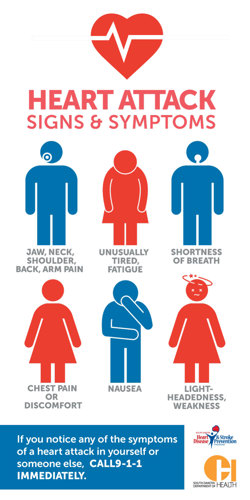A heart attack (myocardial infarction) happens when a part of the heart muscle doesn’t get enough blood.
The more time that passes without treatment to restore blood flow, the greater the damage to the heart muscle.

Signs and Symptoms
Learn the warning signs of a heart attack. Call 9-1-1 at the first sign of heart attack:
- Chest discomfort or pain in the middle of the chest that lasts more than a few minutes, or that goes away and comes back. It may feel like uncomfortable pressure, squeezing, fullness, or pain.
- Discomfort in other areas of the upper body. Symptoms may include pain or discomfort in one or both arms, the back, neck, jaw, or stomach.
- Shortness of breath that may occur with or without chest discomfort.
- Other signs include breaking out in a cold sweat, feeling weak, nauseous, or lightheaded.
If you are possibly having a heart attack, call 9-1-1 immediately!
Risk Factors and Heart Attack Prevention
Some risk factors such as race, sex, age, and family history cannot be changed, but there are things you can do to lower your chances of having a heart attack.
- Manage your blood pressure. Find information on knowing and managing your blood pressure numbers on the High Blood Pressure webpage.
- Manage your cholesterol levels. For more information, visit the American Heart Association’s website.
- Maintain a healthy weight. Eat healthy meals and stay active.
- Quit smoking. Visit the SD QuitLine or call 1-866-SD-QUITS (737-8487) for tools and support to quit tobacco.
- Manage your diabetes. People with diabetes can lower their risk by controlling their blood glucose, blood pressure, and cholesterol.
- Take all your medications as prescribed.
- Attend your follow-up appointments as scheduled.
